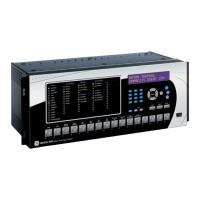5-248 M60 Motor Protection System GE Multilin
5.7 CONTROL ELEMENTS 5 SETTINGS
5
The broken rotor bar detection function uses the same source as other motor protection functions. This source is defined by
the SYSTEM SETUP MOTOR MOTOR LINE SOURCE setting. The following items must addressed for the broken rotor
bar detection function to operate:
• Phase currents must be configured on this source for the broken rotor bar detection function.
•The AC INPUT WAVEFORMS oscillography setting must not be “Off”.
• The thermal model must be enabled.
This function monitors only phase A current.
When the broken rotor bar detection function is enabled, an alarm is initiated once the value of ratio of the broken bar
related sideband component versus the system fundamental component is greater than the pickup level for two consecu-
tive measurements. To reduce probability of a false alarm (caused by impairments other than a rotor bar failure), the ele-
ment is active only if the following conditions hold.
• The motor status is “Running” and the motor load is between preset minimum acceptable value and a value just below
the overload (defined by MOTOR FULL LOAD AMPS × MOTOR OVERLOAD FACTOR).
Trying to detect the broken rotor bar during a motor start will return an incorrect result because of the rapid movement
of broken rotor bar components and a heavy change in the motor current. On the other hand, while the motor load is
small, there is not enough resolution to accurately calculate a miniscule spectral component caused by a rotor bar fail-
ure.
• The motor load is steady.
Variations in motor load cause spectral components that can be misinterpreted as rotor bar failure. Instantaneous
motor load values are collected alongside with data for the broken rotor bar algorithm to prevent this from happening.
The average motor load and its standard deviation are calculated. If the standard deviation is greater than its corre-
sponding setting, the data set is discarded and the broken bar algorithm is not initiated.
• The motor current unbalance is below a corresponding setpoint.
The excessive current unbalance stresses the motor, and it may cause a false broken rotor bar detection.
MESSAGE
START OF BRB
OFFSET: 0.40 Hz
Range: –12.00 to 11.99 Hz in steps of 0.01
MESSAGE
END OF BRB
OFFSET: 2.00 Hz
Range: –11.99 to 12.00 Hz in steps of 0.01
MESSAGE
BRB START BLOCK
DELAY: 60.00 s
Range: 0.00 to 600.00 s in steps of 0.01
MESSAGE
MINIMUM MOTOR LOAD:
0.70 x FLA
Range: 0.50 to 1.00 × FLA in steps of 0.01
MESSAGE
MAX. LOAD DEVIATION:
0.10 x FLA
Range: 0.50 to 1.00 × FLA in steps of 0.01
MESSAGE
MAXIMUM CURRENT
UNBALANCE: 15.0%
Range: 0.0 to 100.0% in steps of 0.1
MESSAGE
BROKEN ROTOR BAR
PICKUP: -40 dB
Range: –60 to –12 dB in steps of 1
MESSAGE
BROKEN ROTOR BAR
RESET DLY: 1.00 s
Range: 0.00 to 600.00 s in steps of 0.01
MESSAGE
BRB BLOCK:
Off
Range: FlexLogic operand
MESSAGE
BROKEN ROTOR BAR
TARGET: Self-reset
Range: Self-reset, Latched, Disabled
MESSAGE
BROKEN ROTOR BAR
EVENTS: Disabled
Range: Disabled, Enabled

